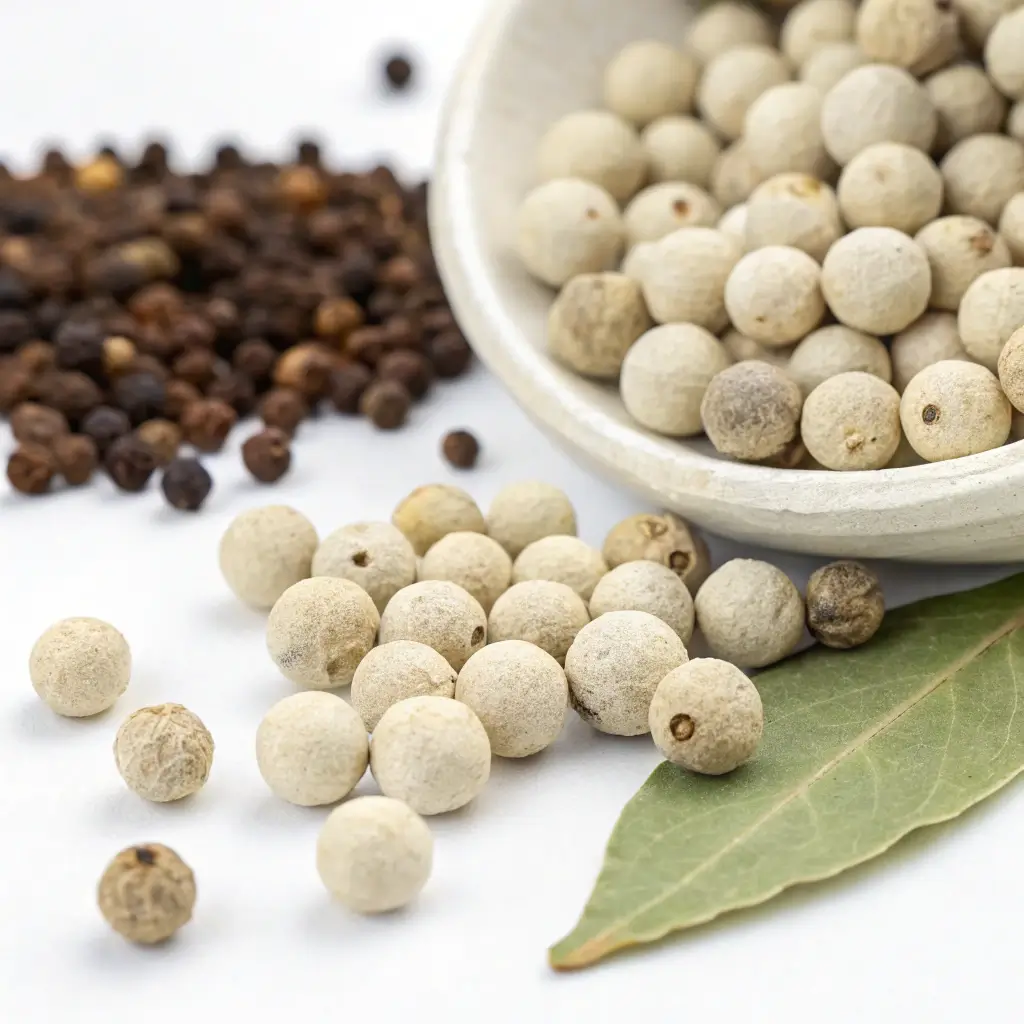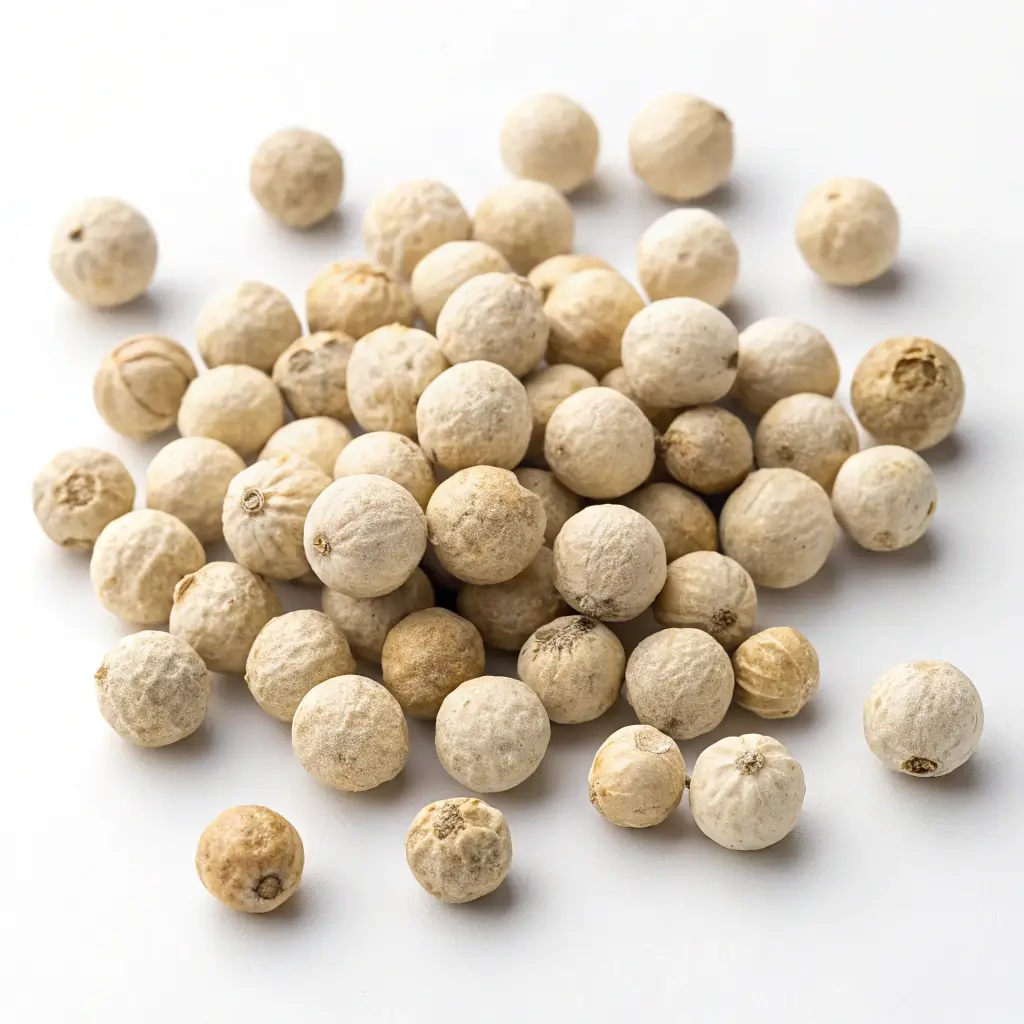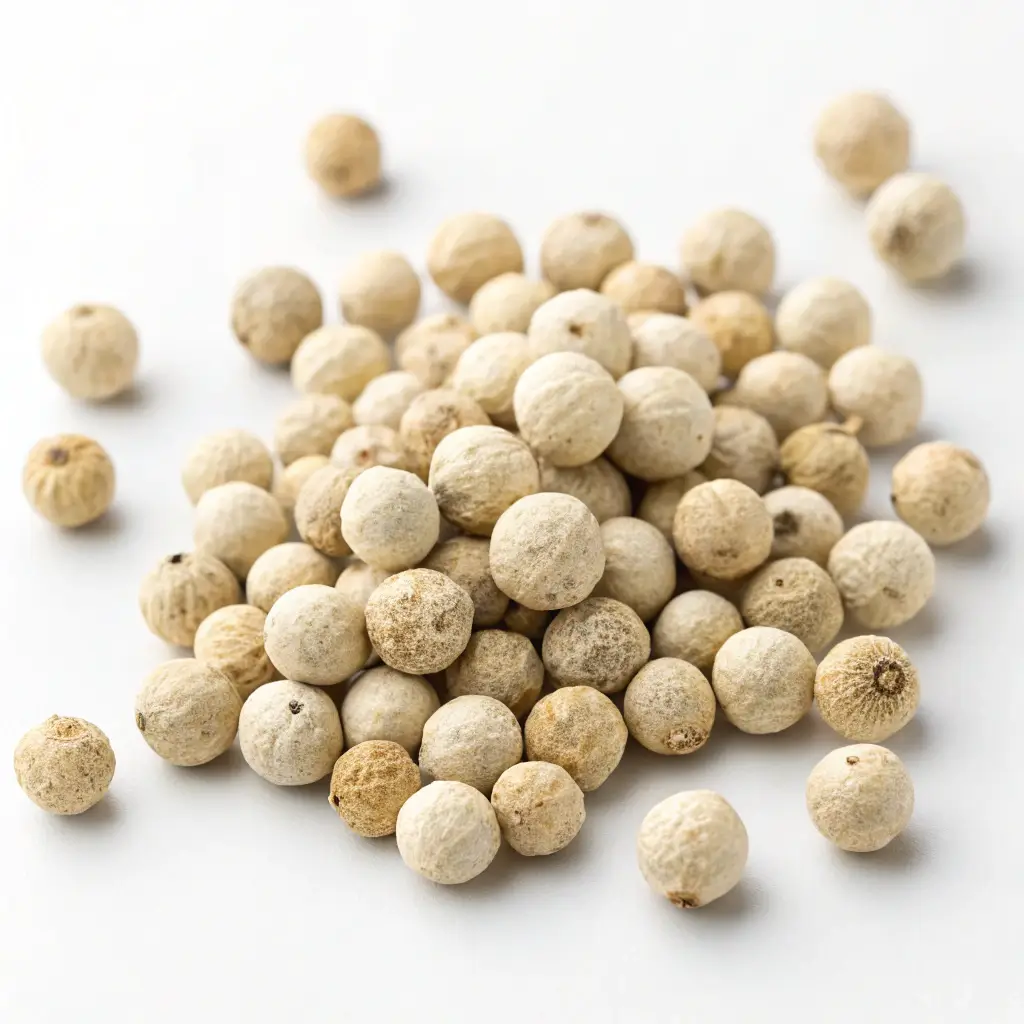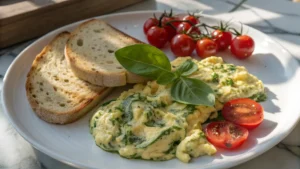When it comes to seasoning food, black pepper often steals the spotlight. But behind the scenes, white peppercorn has been quietly adding heat and complexity to dishes across cultures for centuries. Beyond flavor, this unassuming spice offers unique health benefits, a fascinating history, and a variety of practical uses in the kitchen and beyond.
If you’re interested in natural wellness, traditional remedies, or simply expanding your spice rack, white peppercorn deserves your attention. This article covers everything you need to know from its benefits and taste, to how it’s made, how to grind it, and what makes Sarawak white peppercorns so special.
Let’s dive in.
What Is White Peppercorn?
White peppercorn is the dried seed of the ripe berries from the Piper nigrum plant, the same plant that produces black, green, and red peppercorns. What makes white pepper unique is the way it’s processed: after the berries ripen fully on the vine, they’re soaked in water to ferment and remove the outer skin, leaving only the inner white seed.
This simple yet transformative step results in a peppercorn that has a smoother, more subtle heat compared to black peppercorns, with an earthy, fermented flavor and less aromatic intensity. Because of its pale appearance, it’s often used in light-colored dishes like creamy sauces, mashed potatoes, or soups, where black specks would be visually unappealing.
In both culinary and traditional medicinal uses, white pepper has been valued for its digestive and anti-inflammatory properties. It holds a special place in Asian, European, and Middle Eastern cuisines proof that this unassuming spice has global appeal far beyond the shadow of its darker sibling.
White Peppercorn Benefits
White peppercorns are more than just a spice, they’re a functional food with a variety of benefits:
1. Anti-Inflammatory Properties
White pepper contains piperine, a powerful compound also found in black pepper. Piperine has been shown to reduce inflammation, which is linked to chronic conditions like arthritis, diabetes, and heart disease.
2. Aids in Digestion
Traditionally used in Ayurvedic and Chinese medicine, white pepper stimulates the production of digestive enzymes and improves gut health. It’s often used to relieve indigestion, gas, and bloating.
3. Supports Brain Function
Piperine may enhance cognitive function by increasing the bioavailability of nutrients like curcumin (from turmeric). Some studies suggest it could support memory and focus.
4. Antioxidant Rich
White pepper is packed with antioxidants, helping to combat free radicals in the body and reduce oxidative stress, a major factor in aging and disease.
5. Natural Decongestant
Feeling stuffy? White pepper is often used in hot soups and broths for its ability to clear nasal passages and relieve cold symptoms.

White Peppercorn Plant
The white peppercorn comes from the same plant as black pepper, Piper nigrum. The difference lies in how the berries (drupes) are processed.
- White peppercorns are harvested when fully ripe, then soaked to remove the outer skin, leaving just the inner seed.
- The result is a paler spice with a milder aroma and earthier, fermented taste.
The Piper nigrum plant is a tropical climbing vine, native to southern India but now grown widely across Southeast Asia, including Malaysia and Indonesia.
White Peppercorn Grinder: Choosing the Right Tool
To get the most flavor from white peppercorns, it’s best to grind them fresh. But not all grinders are created equal:
- Use a ceramic grinder instead of metal, white pepper can react with metal and alter its taste.
- Electric grinders offer convenience but may overheat the spice, dulling the flavor.
- A dedicated white pepper grinder is ideal, as the aroma can linger and mix with other spices in multi-purpose tools.
Freshly ground white pepper releases a subtler aroma compared to black pepper, making it perfect for creamy sauces, soups, and light-colored dishes where dark flecks might be unwanted.
White Peppercorns Substitute
Can’t find white pepper? No worries, several substitutes can deliver a similar kick:
- Black pepper (best for heartier dishes; stronger aroma)
- Ground ginger (offers warmth but not the same sharpness)
- Pink peppercorns (milder and slightly sweet, best for salads)
- Green peppercorns (fresher, less pungent; great in sauces)
Tip: If you’re cooking a white or cream-colored dish and want to avoid black flecks, opt for white pepper powder or ground ginger as a visual match.
White Peppercorn Powder
White peppercorn powder is simply finely ground white peppercorns. It’s:
- Convenient for cooking, baking, and blending into spice mixes.
- Less pungent than black pepper powder, with a more fermented, musty note.
- Frequently used in Asian cuisine, especially Chinese, Vietnamese, and Thai soups, sauces, and seafood dishes.
To preserve its flavor:
- Store in an airtight container, away from light.
- Use within 6 months for maximum potency.
White Peppercorn Taste
White pepper is often described as:
- Less aromatic than black pepper.
- Having a milder heat, but a sharper bite that hits quickly and fades.
- With earthy, fermented, or even slightly floral undertones.
It complements:
- Cream sauces
- Light soups (like egg drop or hot and sour)
- Mashed potatoes
- White fish
- Poultry
Its unique flavor profile makes it a favorite in recipes where the spice should blend in, not dominate.

Sarawak White Peppercorns
Originating from Sarawak, Malaysia, these peppercorns are considered some of the finest in the world.
What makes Sarawak white peppercorns special?
- Grown in ideal tropical climates with rich soil.
- Hand-harvested and traditionally processed for maximum flavor.
- Known for a bright, complex flavor with subtle citrusy notes.
Chefs and spice enthusiasts love Sarawak pepper for its consistency, freshness, and premium quality. It’s widely used in high-end kitchens and gourmet products.
Science-Backed Facts About White Peppercorn
While much of white pepper’s use is traditional, research backs several of its claims:
- Piperine, its active compound, has been shown to increase bioavailability of certain nutrients by up to 2000%, especially curcumin (from turmeric).
- Studies have found that white pepper may help regulate blood sugar levels in animals, though human studies are ongoing.
- Its antioxidant content may help protect the liver and support immune function.
Source: Journal of Food Science and Technology, National Institutes of Health (NIH)
Conclusion: Don’t Overlook the Power of White Peppercorn
Whether you’re a wellness seeker, spice lover, or just curious about new flavors, white peppercorns offer more than meets the eye. With their unique health benefits, culinary versatility, and rich cultural history, they deserve a place in your pantry and your health routine. You can also discover the difference between the white and black Peppercorns.
If you found this guide helpful, feel free to share it, drop a comment, and make sure you Follow on Facebook. Who knew something so small could do so much?
FAQs about White Peppercorn
Why do Chinese use white pepper instead of black pepper?
In Chinese cuisine, white pepper is favored for its flavor profile, it’s milder, blends well into soups and broths, and doesn’t leave black flecks. It’s especially popular in hot and sour soup, congee, and light seafood dishes.
What can I use instead of white peppercorns?
Substitutes include:
– Black pepper (stronger and darker)
– Ground ginger (warm and earthy)
– Green peppercorns (milder, fresher)
– Pink peppercorns (sweet-spicy, best for raw applications)
Is Sichuan peppercorn the same as white peppercorn?
No, they’re completely different:
– Sichuan peppercorn comes from the prickly ash tree and has a numbing, citrusy flavor.
– White peppercorn comes from Piper nigrum and has a mild heat with earthy, fermented notes.
Can you grow white peppercorns?
Yes, but it’s a challenge:
– It grows on the Piper nigrum vine, which requires tropical, humid conditions, regular rainfall, and rich soil.
– It can take 3–4 years to mature and needs support for climbing.
More common in India, Indonesia, Vietnam, and Malaysia.




